| Many excellent third-party tools are available to enhance management of NDS/eDirectory. The following sections briefly discuss a number of the tools we have looked at and use frequently in production networks: JRB utilities, tools by Wolfgang Schreiber, Novell's ScheMax tool, and DS Expert and DS Analyzer from NetPro. NOTE Appendix D, "eDirectory Resources," lists links to additional NDS /eDirectory resources and third-party tools.
JRB Utilities The JRB software is a collection of more than 120 programs and NetWare Loadable Module (NLMs). The majority of the programs are provided in both 32-bit and 16-bit versions. Generally known as JRButils , the set of utilities covers almost every aspect of managing NetWare 3.11 through 6.5. The utilities are mostly command-line based, and they provide considerably greater flexibility than the tools shipped with NetWare. They are particularly suited to managing large numbers of users. At the time of this writing, JRButils version 10.0 is divided into six parts : -
Part 1 is comprised of 32-bit console (character-mode) utilities for use from Windows 95/98/Me and NT/2000/XP/2003 clients . There are 121 programs in this part. -
Part 2 is comprised of 101 32-bit utilities that are command-line based but produce graphical output. These utilities are a subset of those in Part 1, excluding those that typically perform small tasks without output. They can also be run without opening a window, allowing them to run "silently" from batch files and scripts. -
Part 3 is comprised of 22 utilities that have full graphical interfaces for both input and output. With the exception of jrbpass and spacemon, which are provided only as full graphical programs, these programs are from Part 1. -
Part 4 is comprised of 16-bit DS-aware programs for use from DOS or from a Windows command prompt. There are 93 programs in this section. -
Part 5 is comprised of 78 bindery utilities plus David Harris's home and sethome programs. These are 16-bit DOS programs for use on NetWare 3.x, and most of them can be used against NDS/eDirectory servers, provided that the appropriate bindery contexts are defined. -
Part 6 is comprised of two NLMs for running on NetWare servers. They are OPENFILE.NLM and MAKEHOME.NLM . NOTE The 16-bit bindery-based programs of JRButils can be freely downloaded from www.jrbsoftware.com . To obtain copies of individual utilities for evaluation, you can send a request to support@jrbsoftware.com.
The following are some of the tools in the JRButils collection that are on our top-five list: -
jrbimprt ” This tool is for mass user creation, deletion, and updating. It supports creation of GroupWise users, creation of GroupWise mailing lists, and setting of NetWare, GroupWise, Simple, and NDS for Windows NT passwords. It is an excellent replacement for Novell's UImport utility. -
Jrbpass ” This tool is a GUI password changer that supports NetWare, GroupWise, Simple, NDS for NT, and NT domain passwords (see Figure 12.17). Figure 12.17. Jrbpass, a GUI password changer. 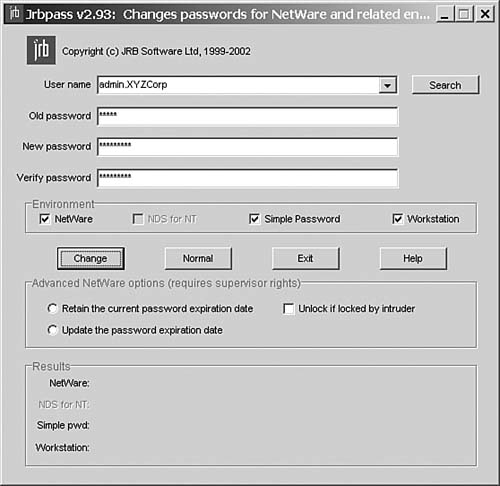
-
sethome2 ” This tool sets the User object's Home Directory attribute en masse and can create home directories. It also sets the file system trustee rights at the same time. -
Setpword ” This tool sets NDS/eDirectory and other types of password (such as GroupWise) for multiple objects. It can also set passwords for non- User objects, as long as the object has ndsLoginProperties as one of its object classes (see Figure 12.18). Figure 12.18. Using Setpword to change a dynamic group object's password. 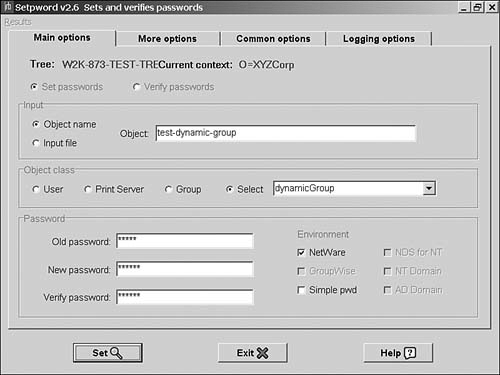
-
JBLookup ” This GUI user lookup utility allows any attributes to be displayed (see Figure 12.19). Figure 12.19. JBLookup, a GUI user information lookup utility. 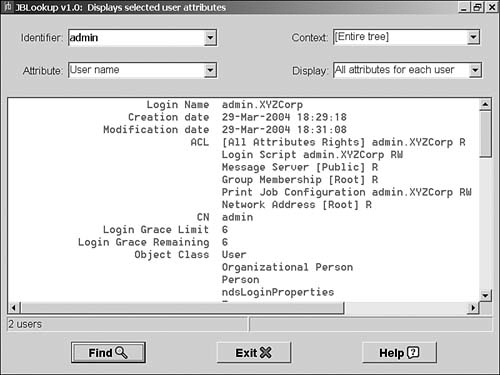
For up-to-date information about the current release of JRButils, visit www.jrbsoftware.com and refer to the Release Notes and Enhancements links. Wolfgang's Tools Similarly to the JRB utilities, the tools developed by Dr. Wolfgang Schreiber (Wolfgang's Tools, as they are normally called) are a collection of standalone utilities that consultants and network administrators should not do without. DSReport and Quick for NDS are the most popular and most useful tools in the collection. NOTE A large majority of Wolfgang's Tools, including DSReport (but not Quick for NDS ), are public domain. You can download the latest version of the tools from www.wolfgangschreiber.de .
DSReport allows you to run reports on any attribute of any object in an NDS/eDirectory tree (see Figure 12.20). The resulting data can be exported into comma-separated, comma- and tab-separated files, Excel files, Quattro Pro files, HTML files, or XML files, or even into the Windows Clipboard. Figure 12.20. Selecting specific User attributes for reporting. 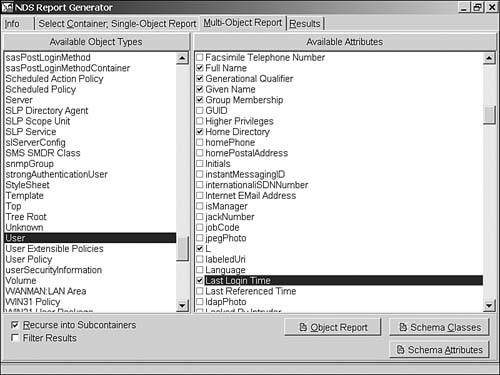
Quick for NDS is a command-line utility that you use to access NDS from the command prompt or from a batch file. Although NetWare Administrator and other tools from Novell are great tools for NDS/eDirectory administration, they have some severe limitations, especially if you need automation. The main purpose of Quick for NDS is to fill these gaps. Quick for NDS allows you to specify the objects that you want to see or modify with object types and/or wildcards, so you work with exactly the objects that you select. You may operate on any specified container, or you may add an option to operate on all matching objects in the whole (sub)tree. Quick for NDS can save you hours of time and reduce errors by automating standard administrative tasks. You can store your standard tasks as batch jobs and run them at your convenience. This can be an alternative for having to develop scripts using awk or Perl for some of your procedures. The following are some examples of uses of Quick for NDS: -
To modify the login scripts of all your OU containers: QUICK LoginScript "organizational unit"=* replace "MAP X:" "MAP Y:"
-
To change the passwords of all students in a given container: QUICK password user=* newpassword /cont=.grade10.highSchool
-
To set the Password Required flag to TRUE for all users in the tree: QUICK restrict user=* pwdReq true /cont=[root] /sub
-
To list the ACL attribute values for all the objects in the O=XYZCorp container: QUICK ForSet .XYZCorp ACL "echo $value$" /qu
The output looks like this: [ R ] O=XYZCorp. / "Login Script" [ R ] O=XYZCorp. / "Print Job Configuration" [ A ]DEMO-W2KC-NDS.O=XYZCorp./"[All Attributes Rights]" [ S ] DEMO-W2KC-NDS.O=XYZCorp. / "[Entry Rights]" [ RW I] pco.OU=Extend.O=XYZCorp. / "ACL" [ RW I] pco.OU=Extend.O=XYZCorp. / "Object Class" [ RW I] pco.OU=Extend.O=XYZCorp. / "bhObjectGUID" [ R I] publicUser.OU=Extend.O=XYZCorp. / "CN" [ RW I] pco.OU=Extend.O=XYZCorp. / "bhCmAcceptList" [ RW I] pco.OU=Extend.O=XYZCorp. / "bhCmApprovedList" [ RW I] pco.OU=Extend.O=XYZCorp. / "bhCmAssignList" [ RW I] pco.OU=Extend.O=XYZCorp. / "bhCmDeniedList" [ RW I] pco.OU=Extend.O=XYZCorp. / "bhCmInviteList"
ScheMax Originally developed by Netoria in Australia, ScheMax is now a discontinued Novell product. ScheMax (pronounced "schema-x") is a utility that allows you to create new schema classes and attributes and to create custom snap-ins for NetWare Administrator to manage the schema extensions. It consists of three components : Schema Administrator, Snapin Builder, and ScheMax Viewer. NOTE Because ScheMax is now discontinued and no longer supported, Novell has made it freely available for download from its Cool Solutions Web site, at www.novell.com/coolsolutions/tools/1214.html.
Schema Administrator The Schema Administrator component of ScheMax is accessible through the Tools menu of NetWare Administrator. When activated, it displays a graphical browser that shows the schema class inheritance tree (see Figure 12.21). Figure 12.21. ScheMax Schema Administrator. 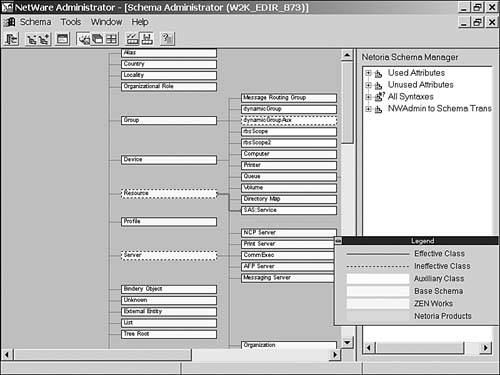
As with the Schema Manager in ConsoleOne, you can use Schema Administrator to add classes and attributes to the DS schema. The real power in ScheMax's Schema Administrator is the presentation. The graphical overview of the schema tree enables you to determine where your new object class appears in the schema tree and gives you greater precision in locating the proper place to put your schema extension. Snapin Builder ScheMax doesn't stop where Schema Manager does; through an ingenious twist, rather than create snap-in DLLs with a development tool, ScheMax includes facilities to build pages for NetWare Administrator and associate them with DS objects. The end result is that you can create schema extensions and build pages right into NetWare Administrator. The pages built with ScheMax are stored directly in NDS/eDirectory, so installation of the snap-in is as easy as associating a Container , Group , or User object with the snap-in object. NOTE Because ScheMax's snap-ins are stored in the DS , you must ensure that ScheMax's schema extension has been applied to the tree. You can manually extend the schema by selecting Tools, Schema Extensions in NetWare Administrator after ScheMax has been installed.
To create a snap-in, you first select the context in which the snap-in object will be created, by selecting Object, Create and then selecting the ScheMax Snapin class. Figure 12.22 shows a sample snap-in page in development. This page includes several standard attributes that are spread through normal administration pages. Figure 12.22. The ScheMax graphical snap-in designer. 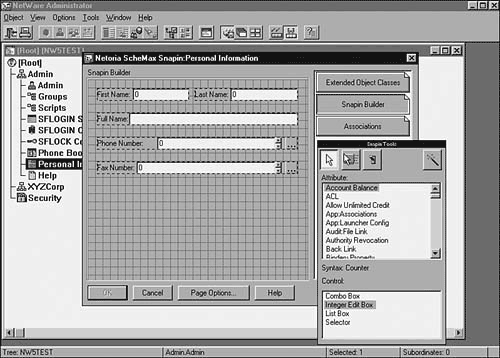
The finalized new attribute page is shown in Figure 12.23. As you can see, the page is accessible directly through the standard NetWare Administrator interface; it appears just the way it would if you spent hours or days developing a snap-in DLL, but using ScheMax takes only a few minutes. Figure 12.23. A ScheMax-built snap-in, added to the User class. 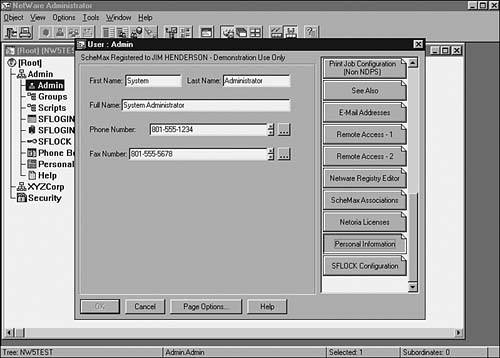
ScheMax Viewer The final component of ScheMax is ScheMax Viewer. In many cases, it would be easiest if users could populate the data in the DS database themselves . ScheMax Viewer can be used for this. The initial view, shown in Figure 12.24, lets the user pick a view to be displayed. Figure 12.24. The ScheMax Viewer view selection screen. 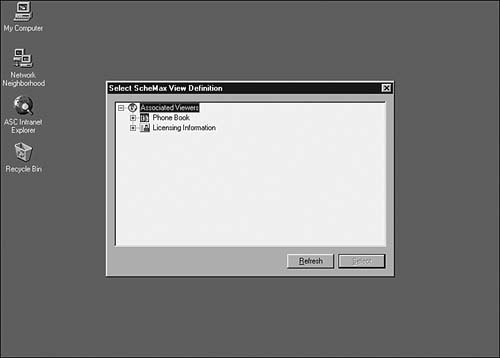
When the view is selected, the user can display information for a particular subtree or for objects in a specific context. Administration of information is just a double-click away; selecting a record from the view brings up associated snap-ins created for the view. The same snap-ins created for NetWare Administrator are available in ScheMax Viewer. The view is also stored in DS and is created with NetWare Administrator. As when you create a ScheMax snap-in, you create a view by selecting the context in which the snap-in object will be created; to do this, you select Object, Create and then select the ScheMax View class. Figure 12.25 shows how the new view looks. Figure 12.25. Creating a view for use with ScheMax Viewer. 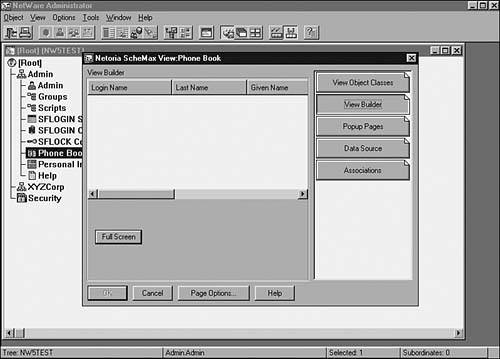
To add the capability to edit data fields, you simply associate a ScheMax snap-in object with the view, as shown in Figure 12.26. Figure 12.26. Associating a s nap-in with a view to enable editing of DS attributes from the viewer. 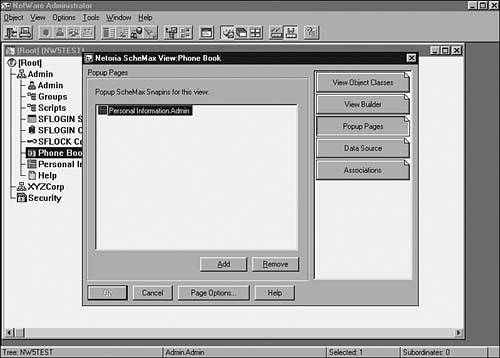
A number of other options are available with ScheMax Viewer. For example, you can force ScheMax Viewer to run for the specific User object logged in and require the ScheMax Viewer fields to be updated before the program can be exited. This is one way you could update a telephone list with current employee information. Another option is the capability to pass a specific view directly into the executable. This prevents the selection screen shown in Figure 12.24 from appearing and launches the desired view directly. DS Expert and DS Analyzer NetPro Computing, Inc. (www.netpro.com) is one of the leading developers of NDS/eDirectory management tools. Its DS Expert and DS Analyzer products can help you monitor and optimize your DS performance and troubleshoot DS problems. The DS Expert product is for monitoring the overall health of an NDS/eDirectory tree. It monitors the directory for replication processes, time synchronization, and directory background processes, such as obituaries and backlinks ”conditions that are vital to the health of the directory. It keeps constant tabs on directory conditions, watching for replication latency issues and synchronization errors that can affect the integrity of the directory and prevent user access to critical services. From stuck obituaries and time sync issues to replica and partition synchronization problems, DS Expert ensures the health of NDS/eDirectory all the time, and it snaps in to whatever management framework you are using. There are two components to the DS Expert product: a server agent and a workstation-based tool to gather and view the information from the agents loaded on the servers. The latest version also allows you to access the agents by using a Web browser. DS Expert has the capability to send SNMP alerts to any standard SNMP management console and react based on user-defined thresholds. A unique feature of DS Expert is its capability to provide multiserver DSTrace functionality. This functionality is provided through the workstation-based management console and enables you to discover more about how DS functions as well as view real-time information about problems in the DS tree. DS Analyzer enables you to analyze, troubleshoot, and tune NDS/eDirectory for optimal performance. DS Analyzer gathers directory traffic and utilization data from across the entire network and displays it in a graphical format, allowing you to quickly trend and analyze the directory traffic on a network. Reports display traffic data from every possible perspective, including servers, partitions, containers, clients, objects, and NDS/eDirectory background processes. With DS Analyzer, you can quickly identify problem areas and drill all the way down to the client level to pinpoint the root causes of directory issues. One of the unique features in DS Analyzer that sets it apart from other DS troubleshooting tools is its integrated knowledge base. This knowledge base provides you with interpretations of directory traffic and recommendations for problem resolution and directory design suggestions. |